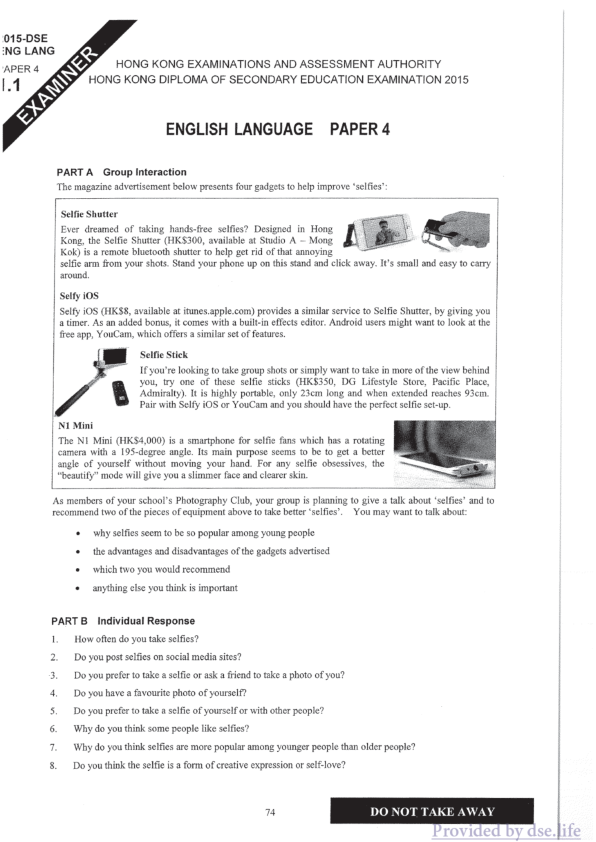2015 DSE 英国语文-English 真题 答案 详解
2015-05-06 dse dse 英国语文-English
| 序号 | 文件列表 | 说明 | ||
|---|---|---|---|---|
| 1 | 2015-英国语文-English-answer.pdf | 14 页 | 7.99MB | 答案 |
| 2 | 2015-英国语文-English-paper1.pdf | 24 页 | 4.80MB | 真题 Paper 1 |
| 3 | 2015-英国语文-English-paper2.pdf | 8 页 | 1.67MB | 真题 Paper 2 |
| 4 | 2015-英国语文-English-paper3.pdf | 48 页 | 8.09MB | 真题 Paper 3 |
| 5 | 2015-英国语文-English-paper4.pdf | 54 页 | 10.91MB | 真题 Paper 4 |
答案
2015-DSE ENGLANG PAPER 4 9.3
HONG KONG EXAMINATIONS AND ASSESSMENT AUTHORITY HONG KONG DIPLOMA OF SECONDARY EDUCATION EXAMINATION 2015
ENGLISH LANGUAGE PAPER 4
GENERAL INSTRUCTIONS This paper consists of two parts: Part A, Group Interaction; and Part B, Individual Response. Part B will immediately follow Part A. DO NOT write anything on this page.
PART A Group interaction You will be given 10 minutes to prepare. The time allowed for the group interaction is 8 minutes (or 6 minutes for a group of 3 candidates). You may make notes on the notecard provided and refer to your notes during the discussion.
Below is an extract from an Australian website about a primary school programme called 'Adopt-A-Grandparent':
About Adopt-A-Grandparent The Australian Adopt-A-Grandparent programme is supported by people who have family spread around the country and even the world. Many of our young children do not have grandparents living close by. In fact some of our children don’t have any grandparents at all. Those families who don’t have grandparents around find that their children lack the presence of an older role model and often don’t know how to relate to and communicate with our older generation. The real shame is that our older generation has so much to offer children by way of skills, knowledge and nurturing.
What is The Adopt-A-Grandparent Programme? Primary schools invite senior volunteers to come to the school and spend time with the children. They read to them, get involved in creative activities, crafts, and play music. Some seniors might tell their story about how things were when they were a kid, something the children love to hear about. Depending on the scheduling system in each school, seniors can volunteer once a month, once a fortnight, or even more frequently. It is totally up to them to express their preference to the school.
Grandparent/Senior Volunteers Schools invite the grandparents of the children who attend the school to volunteer on a regular basis. Alternatively, senior communities in the area of the school can be approached and invited to participate.
Your group is meeting to discuss whether it would be a good idea to start an Adopt-A-Grandparent programme at your school. You may want to talk about: what the grandparents could do and why the benefits of such a programme for the students and the school how you might organize the programme anything else you think is important
PART B Individual Response The examiner will ask you one or more questions based on Part A. You will have up to 1 minute to respond.
MARKING SCHEMES This document was prepared for makers’ reference. It should not be regarded as a set of model answers. Candidates and teachers who were not involved in the marking process are advised to interpret its content with care.
Paper 1 (Reading) Part A (compulsory section)
-
writer of this article // journalist // reporter // interviewer // the person who asks the questions (× writer) [52]
-
several // some more (books) [9]
-
His career: Started working for The Economist [3] Wrote his first book about Korea [4] Became an English teacher [2] Studied at Oxford University [1] [64]
-
(other) westerners (in Korea) // the west/westerners // people (living) in western/other countries // (other) journalists // (other) writers (× most) people (in general) // Koreans [41]
-
D [75]
-
China [45]
-
it is the warmth between people and mutual sacrifice [57]
-
jeong / han are uniquely Korean/exclusive concepts to Korea (× Korea has words to describe these things) [25]
-
to overcome/forget their sadness/sorrow/burden/oppression [22]
-
i) Sadness and happiness both seem to be magnified in Korea // Koreans are/tend to be more emotional/ show more feelings (× show a lot of stoicism / self-control) [17]
ii) Koreans are very expressive and open with their feelings [48]
-
its superficial / it’s not meaningful (× it’s for teenagers) [53]
-
(members of) 3rd Line Butterfly (× a band // Korean Music / culture) [82]
-
Gangnam is superficial/flashy [11]
-
i) NG [72] ii) F [68] iii) T [82]
-
(Korean) drama(s) // (romantic) TV series/programme // soap opera(s) (× Korean soaps // Cinderella stories) [83]
-
the best way to become wealthy/achieve status//to become successful is to marry [62]
-
i) drama(s) // soaps [90] ii
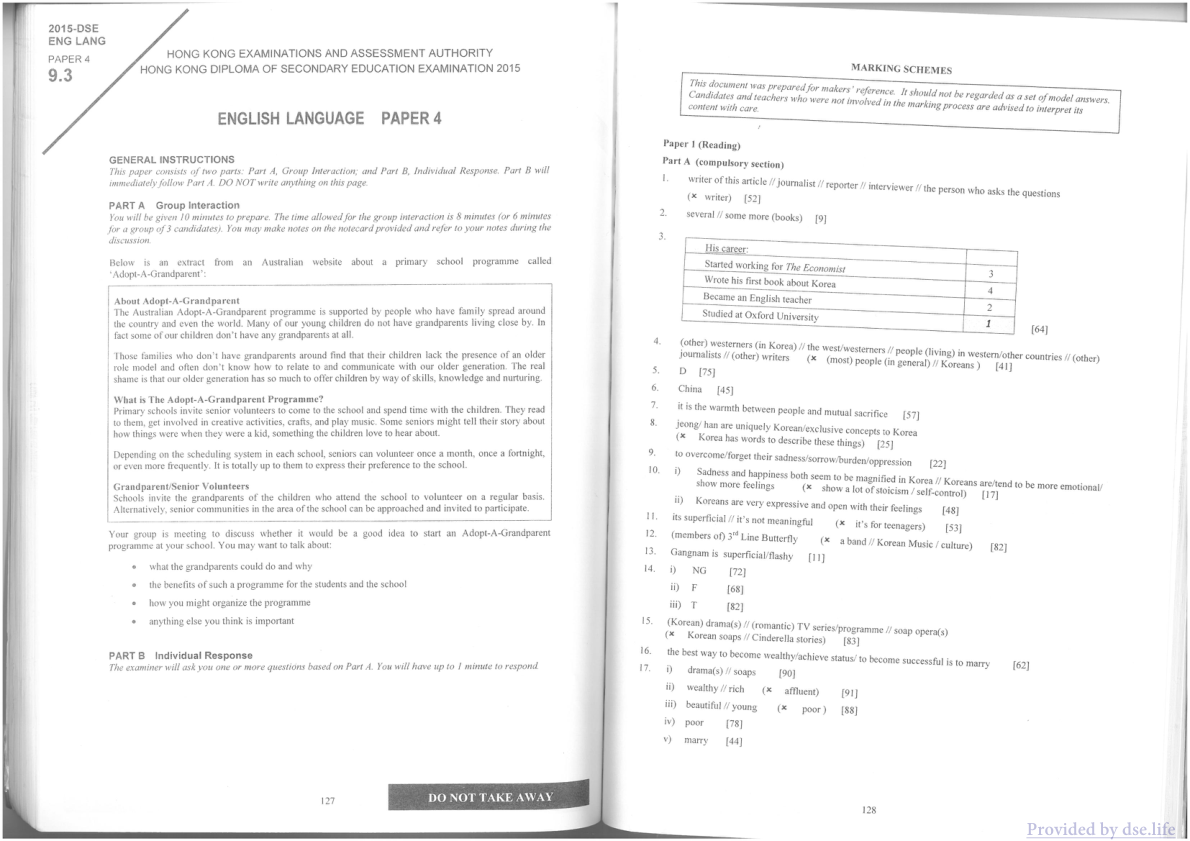
真题 Paper 1
2015-DSE ENG LANG PAPER 1 PART A
HONG KONG EXAMINATIONS AND ASSESSMENT AUTHORITY HONG KONG DIPLOMA OF SECONDARY EDUCATION EXAMINATION 2015
A ENGLISH LANGUAGE PAPER 1 PART A Reading Passages 8:30 am - 10:00 am (1½ hours) (for both Parts A and B)
GENERAL INSTRUCTIONS
(1) There are two parts (A and B) in this paper. All candidates should attempt Part A. In Part B, you should attempt either Part B1 (easier section) OR Part B2 (more difficult section). Candidates attempting Parts A and B2 will be able to attain the full range of levels, while Level 4 will be the highest level attainable for candidates attempting Parts A and B1.
(2) After the announcement of the start of the examination, you should first write your Candidate Number and stick barcode labels in the spaces provided on the appropriate pages of the Part A Question-Answer Book and the Part B Question-Answer Book which you are going to attempt.
(3) Write your answers in the spaces provided in the Question-Answer Books. Answers written in the margins will not be marked.
(4) For multiple-choice questions, you are advised to blacken the appropriate circle with a pencil so that wrong marks can be completely erased with a clean rubber. Mark only ONE answer to each question. Two or more answers will score NO MARKS.
(5) Supplementary answer sheets will be supplied on request. Write your Candidate Number, mark the question number box and stick a barcode label on each sheet and fasten them with string INSIDE the Question-Answer Book.
(6) No extra time will be given to candidates for sticking on barcode labels or filling in the question number boxes after the 'Time is up' announcement.
(7) The two Question-Answer Books you have attempted (one for Part A and one for Part B) will be collected together at the end of the examination. Fasten the two Question-Answer Books together with the green tag provided.
(8) The unused Question-Answer Book for Part B will be collected separately at the end of the examination. This will not be marked. Do not write any answers in it.
INSTRUCTIONS FOR PART A
(1) The Question-Answer Book for Part A is inserted in this Reading Passages booklet.
(2) Attempt ALL questions in Part A. Each question carries ONE mark unless otherwise stated.
© Hong Kong Examinations and Assessment Authority All Rights Reserved 2015
2015-DSE-ENG LANG I-A-RP-I
Not to be taken away before the end of the examination session
Provided by dse.life
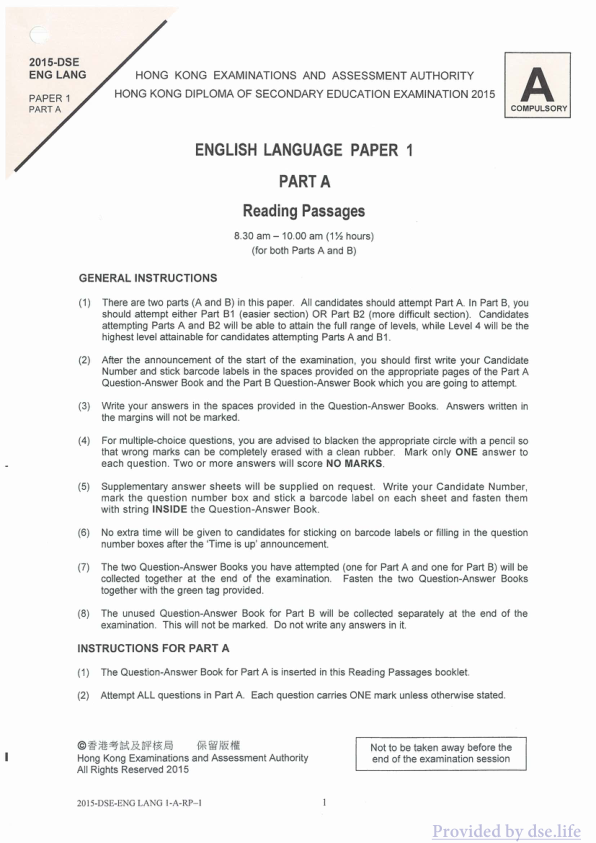
真题 Paper 2
2015-DSE ENG LANG PAPER 2
HONG KONG EXAMINATIONS AND ASSESSMENT AUTHORITY HONG KONG DIPLOMA OF SECONDARY EDUCATION EXAMINATION 2015
ENGLISH LANGUAGE PAPER 2 Question-Answer Book
11:00 am - 1:00 pm (2 hours) (for both Parts A and B)
INSTRUCTIONS
-
There are two parts (A and B) in this paper. Candidates should attempt Part A and ONE question from Part B.
-
After the announcement of the start of the examination, you should first write your Candidate Number in the space provided on Page 1 and stick barcode labels in the spaces provided on Pages 1 and 3.
-
For Part B, you should put an 'X' in the corresponding question number box on Page 6 to indicate the question you are going to attempt.
-
Write your answers in the space provided in this Question-Answer Book. Answers written in the margins will not be marked.
-
Do not use your real name in answering any of the questions. If names are provided in the question, you must use those names. If no name is provided and you still wish to use a name to identify yourself, then use ‘Chris Wong’. If you need to use names for other characters in the composition not specified by the question, you may use names such as Mary, Peter, Mr Smith, Ms Young, etc. You may lose marks if you do not follow these instructions.
-
Rough work should be done on the rough-work sheets which will be collected separately. These will not be marked.
-
Supplementary answer sheets will be supplied on request. Write your Candidate Number, mark the question number box and stick a barcode label on each sheet and fasten them with string INSIDE this book.
-
No extra time will be given to candidates for sticking on the barcode labels or filling in the question number boxes after the ‘Time is up’ announcement.
© 香港考試及評核局保留版權 Hong Kong Examinations and Assessment Authority All Rights Reserved 2015
2015-DSE-ENG LANG 2-1
Candidate Number
Please stick the barcode label here.
A020E002
Provided by dse.life
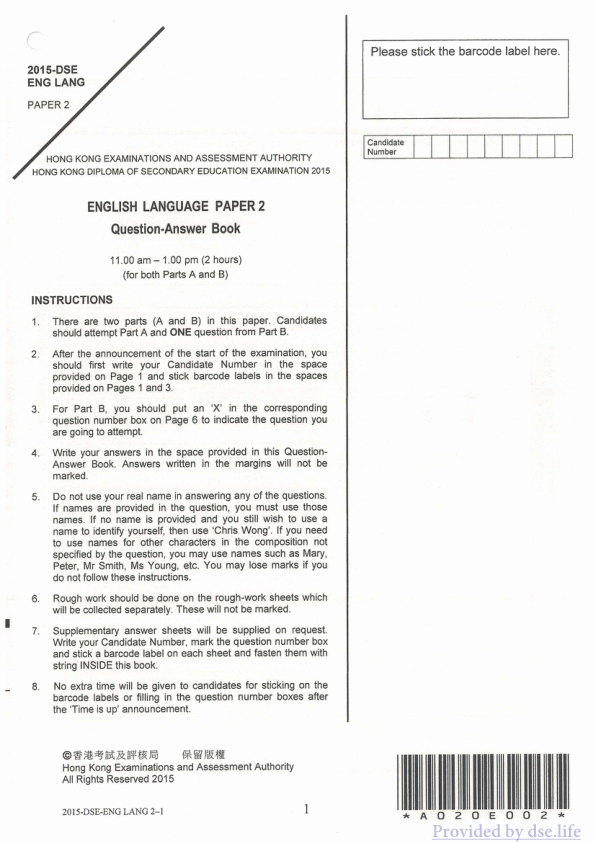
真题 Paper 3
2015-DSE ENG LANG PAPER 3 PART A
A COMPULSORY
HONG KONG EXAMINATIONS AND ASSESSMENT AUTHORITY HONG KONG DIPLOMA OF SECONDARY EDUCATION EXAMINATION 2015
ENGLISH LANGUAGE PAPER 3 PART A Question-Answer Book
GENERAL INSTRUCTIONS
(1) There are two parts (A and B) in this paper. All candidates should attempt ALL tasks in Part A. In Part B, you should attempt either Part B1 (easier section) OR Part B2 (more difficult section). Candidates attempting Parts A and B2 will be able to attain the full range of levels, while Level 4 will be the highest level attainable for candidates attempting Parts A and B1.
(2) Write your Candidate Number and stick barcode labels in the spaces provided on the appropriate pages of Part A Question-Answer Book and both Part B Question-Answer Books.
(3) Write your answers clearly and neatly in the spaces provided in the Question-Answer Books. Answers written in the margins will not be marked. You are advised to use a pencil for Part A.
(4) All listening materials will be played ONCE only.
(5) Supplementary answer sheets will be supplied on request. Write your Candidate Number, mark the question number box and stick a barcode label on each sheet and fasten them with string INSIDE the Question-Answer Book.
(6) The rough-work sheets provided are for you to take notes. They will be collected separately and will not be marked.
(7) No extra time will be given to candidates for sticking on the barcode labels or filling in the question number boxes after the 'Time is up' announcement.
(8) The two Question-Answer Books attempted by candidates (one for Part A and one for Part B) will be collected together at the end of the examination. Fasten the two Question-Answer Books together with the green tag provided.
(9) The other unused Question-Answer Book for Part B will be collected separately at the end of the examination. This will not be marked. Do not write any answers in it.
© Hong Kong Examinations and Assessment Authority All Rights Reserved 2015
2015-DSE-ENG LANG 3-A-1
Please stick the barcode label here.
Candidate Number
A020E03A
Provided by dse.life
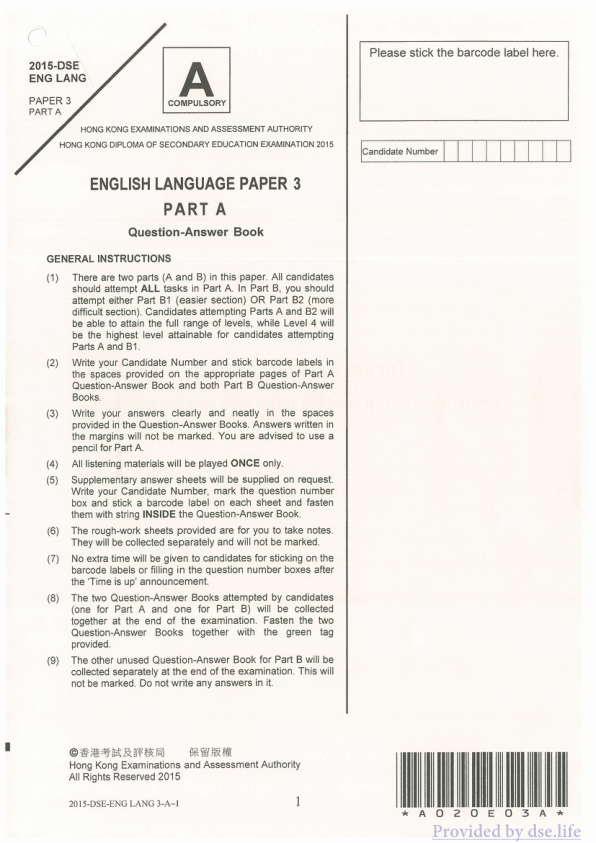
真题 Paper 4
2015-DSE ENGLANG PAPER 4 1.1 EXAMINER HONG KONG EXAMINATIONS AND ASSESSMENT AUTHORITY HONG KONG DIPLOMA OF SECONDARY EDUCATION EXAMINATION 2015 ENGLISH LANGUAGE PAPER 4 PART A Group Interaction The magazine advertisement below presents four gadgets to help improve 'selfies': Selfie Shutter Ever dreamed of taking hands-free selfies? Designed in Hong Kong, the Selfie Shutter (HK$300, available at Studio A - Mong Kok) is a remote bluetooth shutter to help get rid of that annoying selfie arm from your shots. Stand your phone up on this stand and click away. It's small and easy to carry around. Selfy iOS Selfy iOS (HK$8, available at itunes.apple.com) provides a similar service to Selfie Shutter, by giving you a timer. As an added bonus, it comes with a built-in effects editor. Android users might want to look at the free app, YouCam, which offers a similar set of features. Selfie Stick If you're looking to take group shots or simply want to take in more of the view behind you, try one of these selfie sticks (HK$350, DG Lifestyle Store, Pacific Place, Admiralty). It is highly portable, only 23cm long and when extended reaches 93cm. Pair with Selfy iOS or YouCam and you should have the perfect selfie set-up. N1 Mini The N1 Mini (HK$4,000) is a smartphone for selfie fans which has a rotating camera with a 195-degree angle. Its main purpose seems to be to get a better angle of yourself without moving your hand. For any selfie obsessives, the "beauty" mode will give you a slimmer face and clearer skin. As members of your school's Photography Club, your group is planning to give a talk about 'selfies' and to recommend two of the pieces of equipment above to take better 'selfies'. You may want to talk about: why selfies seem to be so popular among young people the advantages and disadvantages of the gadgets advertised which two you would recommend anything else you think is important PART B Individual Response 1. How often do you take selfies? 2. Do you post selfies on social media sites? 3. Do you prefer to take a selfie or ask a friend to take a photo of you? 4. Do you have a favourite photo of yourself? 5. Do you prefer to take a selfie of yourself or with other people? 6. Why do you think some people like selfies? 7. Why do you think selfies are more popular among younger people than older people? 8. Do you think the selfie is a form of creative expression or self-love? 74 DO NOT TAKE AWAY Provided by dse.life
